The Dropt region |
How to surf on
the
site : Clic
on the selected sensitive button.
![]()
Contents of the page : in search of the region - "bastides" - castles - other interesting seights - What about the Dropt?
A secret region :
The “hurried tourist” who rushes across the Dropt region doesn’t discover anything interesting : a valley with no great character, uniform hills. It takes more than this superficial eye to grasp the (real) charm of this region. One must take the time : time to stroll in the villages laden with Middle Ages history, time to idle along the country roads, to grasp the harmony of this countryside which looks a little like Tuscany with its light, its welcoming hills and its scattered farms.
In search of the region :
The most pleasant way to discover the region at its deepest is unquestionably by
bicycle. The network of by-roads (“chemins vicinaux”) is in a good state of
repair and the automobile traffic is very scarce. There are many hills, some
steep ; but there are as many restful downhill slopes as tiring uphill slopes…
![]() Top
of the page
Top
of the page
The "bastides" : (see
general map)
All
the tourist guides provide abundant documentation about the Dropt valley
“bastides”. The Blue Guide “Aquitaine” (Hachette), 1998 edition, is the
most interesting and well-researched.
![]() Top
of the page
Top
of the page
The castles : (see general map)
Biron ** (guided tours) : family property of the Gontaud-Biron family until
the end of the XXth century ; at present taken over by the Dordogne “Conseil Général”
(regional council), who is undertaking restoration.
![]() Top
of the page
Top
of the page
A "sauveté" among the "bastides" : Issigeac
Issigeac, main town in the
district, presents an original characteristic in this region : it is not a
“bastide” but a “sauveté” !.
It is typical of the image one has of a medieval village :
winding alleys, half-timbered houses and corbelled constructions.
![]() Top
of the page
Top
of the page
Others interesting seights :
“Pile-up”
houses (“maisons à empilage” – Castillonnès / Villeréal area ; origin :
Middle Ages) :
 The walls of these houses were originally made of horizontal pilings of
tree trunks (generally oaks), squared off and assembled “à mi-bois” in the
angles. The openings were reduced to a strict minimum : a low and narrow door,
two or three little openings for light. These small “forts” were probably
designed to protect the people from the gangs of pillagers who ransacked the
area.
The walls of these houses were originally made of horizontal pilings of
tree trunks (generally oaks), squared off and assembled “à mi-bois” in the
angles. The openings were reduced to a strict minimum : a low and narrow door,
two or three little openings for light. These small “forts” were probably
designed to protect the people from the gangs of pillagers who ransacked the
area.
Later on, the “pile-up” houses were turned into dwellings by the
extension of the openings and the addition of a half-timbered storey.
Pigeon houses (" pigeonniers") :
Separate
or attached to buildings, entirely built or mounted on pillars, of circular or
rectangular or hexagonal section, the pigeon houses are an omnipresent element
of the scenery in the whole region.
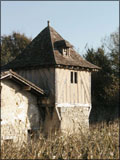
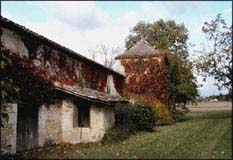
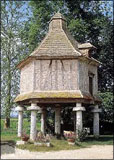
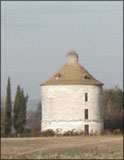
![]() Top
of the page
Top
of the page
What about the Dropt ?
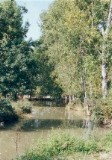
The
Dropt, for centuries, was used as a swimming pool, a washing place and a
fishpond by the locals. Nobody today would bathe with pleasure or wash their
linen in the Dropt. Its waters, muddy in winter and dull in summertime, are not
attractive. Its level can rapidly fall by more than one metre, revealing muddy
banks, mined by coypus (“ragondins”,
unsavoury animals).
![]() Top
of the page
Top
of the page
Bibliography : En
Agenais. S.Baumont. Ed.Privat